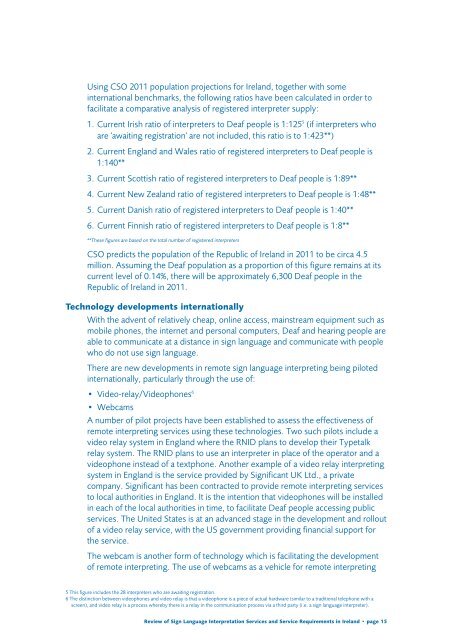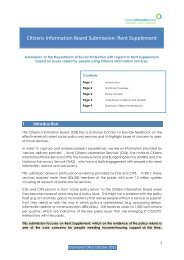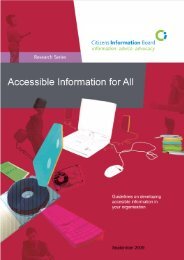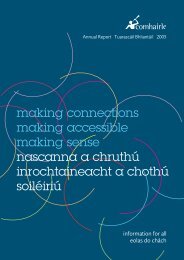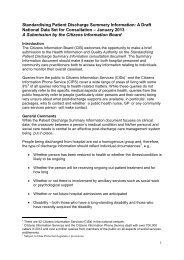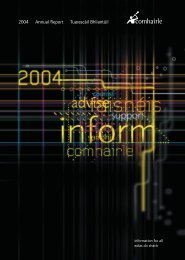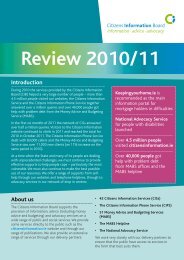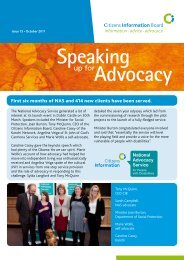Review of Sign Language Interpretation Services and Service ...
Review of Sign Language Interpretation Services and Service ...
Review of Sign Language Interpretation Services and Service ...
- No tags were found...
You also want an ePaper? Increase the reach of your titles
YUMPU automatically turns print PDFs into web optimized ePapers that Google loves.
Using CSO 2011 population projections for Irel<strong>and</strong>, together with someinternational benchmarks, the following ratios have been calculated in order t<strong>of</strong>acilitate a comparative analysis <strong>of</strong> registered interpreter supply:1. Current Irish ratio <strong>of</strong> interpreters to Deaf people is 1:125 5 (if interpreters whoare 'awaiting registration' are not included, this ratio is to 1:423**)2. Current Engl<strong>and</strong> <strong>and</strong> Wales ratio <strong>of</strong> registered interpreters to Deaf people is1:140**3. Current Scottish ratio <strong>of</strong> registered interpreters to Deaf people is 1:89**4. Current New Zeal<strong>and</strong> ratio <strong>of</strong> registered interpreters to Deaf people is 1:48**5. Current Danish ratio <strong>of</strong> registered interpreters to Deaf people is 1:40**6. Current Finnish ratio <strong>of</strong> registered interpreters to Deaf people is 1:8****These figures are based on the total number <strong>of</strong> registered interpretersCSO predicts the population <strong>of</strong> the Republic <strong>of</strong> Irel<strong>and</strong> in 2011 to be circa 4.5million. Assuming the Deaf population as a proportion <strong>of</strong> this figure remains at itscurrent level <strong>of</strong> 0.14%, there will be approximately 6,300 Deaf people in theRepublic <strong>of</strong> Irel<strong>and</strong> in 2011.Technology developments internationallyWith the advent <strong>of</strong> relatively cheap, online access, mainstream equipment such asmobile phones, the internet <strong>and</strong> personal computers, Deaf <strong>and</strong> hearing people areable to communicate at a distance in sign language <strong>and</strong> communicate with peoplewho do not use sign language.There are new developments in remote sign language interpreting being pilotedinternationally, particularly through the use <strong>of</strong>:• Video-relay/Videophones 6• WebcamsA number <strong>of</strong> pilot projects have been established to assess the effectiveness <strong>of</strong>remote interpreting services using these technologies. Two such pilots include avideo relay system in Engl<strong>and</strong> where the RNID plans to develop their Typetalkrelay system. The RNID plans to use an interpreter in place <strong>of</strong> the operator <strong>and</strong> avideophone instead <strong>of</strong> a textphone. Another example <strong>of</strong> a video relay interpretingsystem in Engl<strong>and</strong> is the service provided by <strong>Sign</strong>ificant UK Ltd., a privatecompany. <strong>Sign</strong>ificant has been contracted to provide remote interpreting servicesto local authorities in Engl<strong>and</strong>. It is the intention that videophones will be installedin each <strong>of</strong> the local authorities in time, to facilitate Deaf people accessing publicservices. The United States is at an advanced stage in the development <strong>and</strong> rollout<strong>of</strong> a video relay service, with the US government providing financial support forthe service.The webcam is another form <strong>of</strong> technology which is facilitating the development<strong>of</strong> remote interpreting. The use <strong>of</strong> webcams as a vehicle for remote interpreting5 This figure includes the 28 interpreters who are awaiting registration.6 The distinction between videophones <strong>and</strong> video relay is that a videophone is a piece <strong>of</strong> actual hardware (similar to a traditional telephone with ascreen), <strong>and</strong> video relay is a process whereby there is a relay in the communication process via a third party (i.e. a sign language interpreter).<strong>Review</strong> <strong>of</strong> <strong>Sign</strong> <strong>Language</strong> <strong>Interpretation</strong> <strong><strong>Service</strong>s</strong> <strong>and</strong> <strong>Service</strong> Requirements in Irel<strong>and</strong> • page 15


